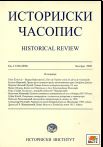Становништво и насеља нахије Петрус у 16. веку
Population and Settlements in the Petrus Nahiye in the 16th Century
Author(s): Gordana Garić Petrović, Dragana AmedoskiSubject(s): History
Published by: Istorijski institut, Beograd
Keywords: demography; population; settlements; Petrus; Sandjak of Kruševac; Ottoman Empire; Serbia; 16th century century
Summary/Abstract: The area, to which medieval and Ottoman historical records refer as Petrus or Petruš, in its widest scope encompassed the upper valley of the Velika Morava River. After the Ottoman conquest and the establishment of new territorial- administrative organization, the vast majority of its population still represented the Christian Serbs (99.5%) belonging to two social groups - re‘âya and eflâk(vlachs). Populations of different status were not living in the distinct areas although re‘âyasettlements and those populated by vlachs were listed in various census books, depending on the revenues collected from their settlers and the services they performed. Vlach villages were administered by knezs. In 1528, in the Petrusnâhiye, two knezs were recorded – Husein and Radonja, under whose jurisdiction were 13 primićurs. All settlements had the status of the village. Paraćin that was listed as a village was also a market- place with a village fair. Comparing the data from five cadastral surveys of the Sandjak of Kruševac, it is apparent that the total population with the status of re‘âya significantly reduced during the 16 th century. This decrease may be the consequence of migrations to areas with more favorable tax system. Besides Ottoman conquests and emigration to newly conquered territories, the plague epidemics also influenced depopulation in some nâhiyes of the Sandjak of Kruševac. In contrast to the demographic decline recorded in some parts of Central Serbia, for the rest of the Balkans, as for the Europe as a whole, the 16th century was the time of tremendous population growth. One of the reasons for these different demographic phenomena may be the change of the status of larger population group, such as vlachs. In addition, the explanation can be also found in the change of the tax and census practice in a particular territory indicated by fluctuation of the percentage of mücerredin the total adult male population. Thus, the change in the age limit for registration in the tax census books could substantially increase revenues from certain taxes, or, on the other hand, create favorable tax conditions in order to populate some territories or prevent their depopulation. All above-mentioned issues can be resolved only trough further research that would cover a wider area and a large number of different types of census books.
Journal: Историјски часопис
- Issue Year: 2013
- Issue No: 62
- Page Range: 117-137
- Page Count: 21
- Language: Serbian

